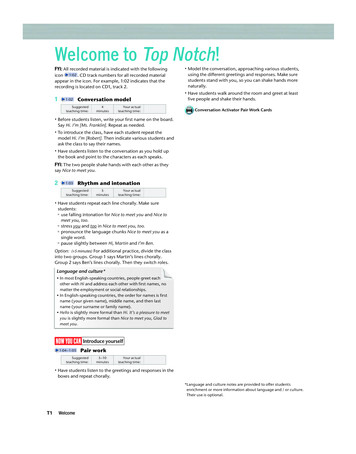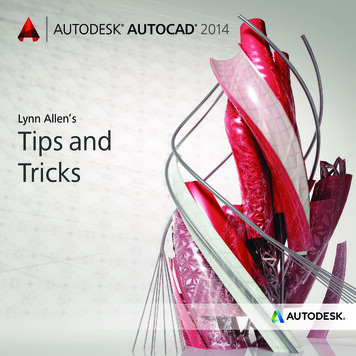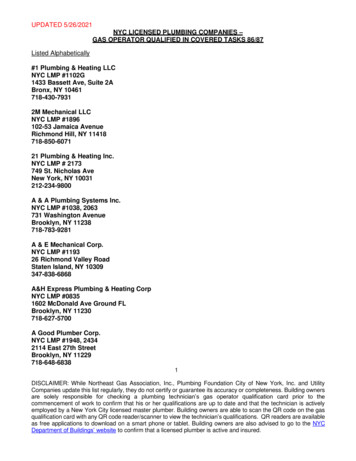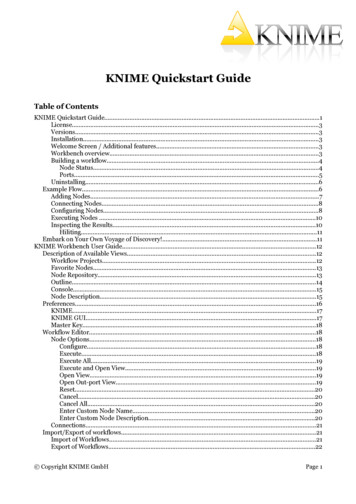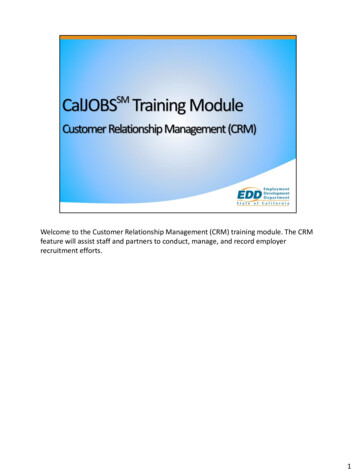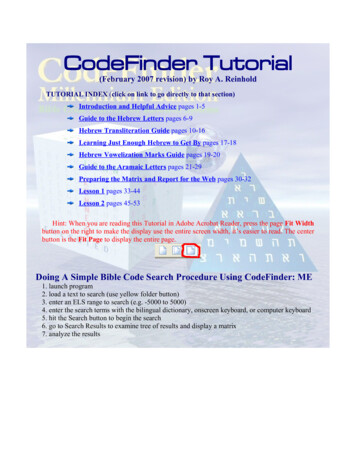
Transcription
CodeFinder Tutorial(February 2007 revision) by Roy A. ReinholdTUTORIAL INDEX (click on link to go directly to that section)Introduction and Helpful Advice pages 1-5Guide to the Hebrew Letters pages 6-9Hebrew Transliteration Guide pages 10-16Learning Just Enough Hebrew to Get By pages 17-18Hebrew Vowelization Marks Guide pages 19-20Guide to the Aramaic Letters pages 21-29Preparing the Matrix and Report for the Web pages 30-32Lesson 1 pages 33-44Lesson 2 pages 45-53Hint: When you are reading this Tutorial in Adobe Acrobat Reader, press the page Fit Widthbutton on the right to make the display use the entire screen width, it’s easier to read. The centerbutton is the Fit Page to display the entire page.Doing A Simple Bible Code Search Procedure Using CodeFinder: ME1. launch program2. load a text to search (use yellow folder button)3. enter an ELS range to search (e.g. -5000 to 5000)4. enter the search terms with the bilingual dictionary, onscreen keyboard, or computer keyboard5. hit the Search button to begin the search6. go to Search Results to examine tree of results and display a matrix7. analyze the results
Introduction and Helpful Adviceby Roy A. ReinholdIf a new user will do the two step-by-step Lessons in this Tutorial, they will learn how to fullyutilize the functions of the software in a couple of days. However, if the new user chooses to ignore theLessons, then they will almost certainly stumble around for 6 months trying to figure it out. My sincereadvice is to do BOTH of the Lessons in the Tutorial.The new CodeFinder: Millennium Edition version 1.23 Bible codes program gives the user veryadvanced tools to make the entire process of Bible codes research faster and easier. Some of the newcutting edge features and capabilities in version 1.23 are listed below:1. Actual/expected numbers in search results. (in Search Results pane)2. Faster import of saved searches.3. Faster Matching.4. Faster display of cached results.5. Extra movable separator bar between search list and search results. (can resize the twopanes in the main screen)6. The search results instantly displays any changes that are made in the search list.7. There is now no limitation on the number of search terms that can be entered, only thecomputer available ram memory limits it now.8. Spaces in terms. (this is a huge change, since it allows your Hebrew terms that are multi-wordto have spaces between the words in Hebrew, while still searching as if it were a long continuousstring. The changes show throughout the program and in the matrix report).9. The program calculates the matrix odds automatically and shows the odds in the matrixreport. A few extra lines have been added in the summary at the bottom of the matrix; where itnow shows total R-value and the matrix odds. An excellent new capability.10. Alternating Word Highlighting (AWH) makes the surface text in the matrix alternate thewords in black and gray so that one can easily recognize the surface text words in the matrix. Toturn AWH on and off, a new menu selection called "Word Highlight" is under the Options menu.This works very well and is an excellent new function.I especially like item 8 above, which allows me to have long terms with spaces between the words.If initially you enter a phrase as a single string without spaces, you can modify it and add spacesbetween words later using Search Parameters. Likewise, the Alternate Word Highlighting featureallows one to read the surface text (if you can read Hebrew) to discern any connections between thesurface text and the matrix terms.Before version 1.23, CodeFinder allowed the user to search in Hebrew, Greek and English texts. Anaddition in this latest version is the Peshitta Aramaic New Testament (NT) for search purposes. I and a2
few others have been investigating the Peshitta Aramaic NT for codes for a few years and it lookspromising; in fact, far more promising than the Greek NT manuscript. We've decided to make thePeshitta NT available now to everyone as a codes search text. Aramaic uses the same alphabet asHebrew and many of the root words are the same. What is different between Hebrew and Aramaic arethe proclitics, which are the prefixes and suffixes added onto the root words. There is no EnglishAramaic dictionary in CodeFinder, because there just aren't any freely available that we could use.Therefore, those desiring to search in the Peshitta Aramaic NT will need to obtain their own bilingualdictionaries and learn on their own about Aramaic word structure and grammar. We don't know yetwhether codes in the Peshitta Aramaic NT are Aramaic or Hebrew or a combination. Aramaic was thelanguage in Israel at the time the New Testament was written.Search Texts Available in CodeFinder: Millennium Editiongenesis.codHebrew (book of Genesis)GreekNT.codGreek (Stephens 1551 Greek NT)kjvnt.codEnglish (King James Version NT)kjvot.codEnglish (King James Version OT)mobydick.codEnglish (entire Moby Dick novel)tanach.codHebrew (entire Tanach or Old Testament)tanachcontroltext.codHebrew (electronically scrambled Tanach)torah.codHebrew (first 5 books of the Bible)torahcontroltext.codHebrew (electronically scrambled Torah)Warandpeace.codHebrew (shortened to Genesis length)peshitta.codAramaic (entire Peshitta Aramaic NT)peshittacontrol.codAramaic (electronically scrambled Peshitta NT)1. The electronically scrambled search texts are for those who want to look ina statistical control text for the same matrix.2. Alternate Word Highlighting is available for the Hebrew Torah and Tanach,and the Peshitta Aramaic NT.3. No one is saying that there is a valid code in the English KJV Old and NewTestaments, but they are useful and fun for practice in learning how to usethe software.4. The order of books in the Hebrew Tanach is different than the EnglishBible. Likewise, the Peshitta Aramaic NT has the order of books different thanthe English Bible and Greek NT.3
Is it possible for a beginner with absolutely no knowledge of Hebrew to search in the Bible codesand find a matrix? Yes, with the help of the built-in bilingual Hebrew-English dictionary inCodeFinder. The printed Ben-Yehuda's Pocket Hebrew-English and English-Hebrew dictionary wouldalso be helpful; and it is very inexpensive, widely available, and better than most other more expensiveprinted dictionaries. The Guide to the Hebrew Letters in the next section in the Tutorial also helps inintroducing the user to the Hebrew alphabet. That's followed by an extremely important section called,Guide to Transliteration of Names. We translate regular words with a dictionary to go from English toits Hebrew equivalent word; meanwhile, we transliterate names of people and place names fromEnglish to Hebrew. The Transliteration Guide in this Tutorial will teach you how to transliteratenames.What about going on from a basic level of finding a simple matrix whose equidistant letter spacing(ELS) terms are single words, to a more advanced level of finding ELS terms that are phrases orsentences as done by more advanced codes researchers? If you've seen me (Roy) on various Bible codeTV specials or read my more recent Bible code matrix articles, you'll see that my matrixes arecomprised of terms that are all phrases and sentences. That's a higher level that takes the Bible codebeyond the possibility of chance occurrence in the universe (scientists use 1 chance in 10 to the 50thpower as the upper level of chance occurrence in the universe; and many use 1 chance in 10 to the 25thpower as the limit for chance occurrence).How does one acquire the necessary skills to do more advanced Bible code matrixes using phrasesand sentences? First, finding a Bible code matrix is no different for a beginner than it is for anadvanced Bible code researcher. We decide on a matrix theme, and then list possible words which fitthe theme for our desired matrix. The next step is to translate those words to Hebrew (for searches inthe Hebrew Torah and Tanach) and type them in as search terms. The software looks for alloccurrences of each term in our search list, and matches them to the occurrences of the main/key term,which is the first term in our search list. Not only does it automatically match the terms; but then thesoftware automatically sorts the results from highest number of matches to lowest. In this way, thesoftware does an incredible amount of work that had to be done manually in the past. That's how wefind a matrix.An advanced Bible codes researcher then goes on to further develop the matrix by “snooping” eachindividual word ELS term in the matrix, to see if it forms a longer phrase or sentence on the theme ofthe matrix. Snooping is merely writing down on paper the term, with the letters before and after it atthat ELS, and then trying to separate the letters into words that form a sentence on the desired theme.However, since we are generally working in Hebrew (a valid code in Aramaic or Greek or English isentirely theoretical, while the Hebrew Bible code has been largely proven by all the many extensivematrixes), the problem of working in Hebrew arises. Anyone can go beyond the beginner level, but itrequires learning Biblical Hebrew Grammar.How can one learn Biblical Hebrew Grammar and why the distinction of Biblical versus ModernHebrew? We've found through many Bible code matrixes, that the Bible code is primarily in4
Biblical Hebrew and not modern Hebrew. Logically, that makes sense. Yes, there is usage of manymodern words like airplane and computer and electricity, etc., but the Bible code is primarily BiblicalHebrew. Modern Hebrew in Israeli newspapers and magazines often uses a different spelling for thesame word when compared with Biblical Hebrew's more compact spelling. After one learns the 22letters in the Hebrew alphabet, then a person can go on from there to learn Biblical Hebrew Grammar,if desired, so that you can develop matrixes with phrases and sentences. You can learn this at home bydoing 1 to 2 lessons a week, and complete the entire curriculum in 6 months or so. In the followingarticle on the Codes in the Bible website, Recommended Publications For The Bible Code, I list thenecessary books to learn Biblical Hebrew Grammar at home as self-study and mention where you canget the books at a very nice discount. This advice is for those who want to go on to an advanced levelin the Bible code; but it is not necessary to initially find code matrixes. You can do that with thematerials at hand. Just do the two step-by-step Lessons to learn how to use the software, and thenutilize the Tutorial Transliteration Guide and the built-in 110,000 word bilingual Hebrew-Englishdictionary that comes with CodeFinder.Some new users write and ask about toggling the Hebrew matrix to English. Technically, that's notpossible. English has 26 letters in the alphabet and Hebrew has 22 letters. Some English letters require2 Hebrew letters to transliterate the sound, and conversely some Hebrew letters require 2 Englishletters to transliterate the sound. Also, in English all the letters are shown in words, while in Hebrewthe short “a” and short “e” sounds are assumed (no letter in the word). For all these reasons, it is notpossible to accurately build software that toggles the Hebrew matrix to English. Additionally, Hebrewsentence structures are different than the normal English sentence with subject-verb-object. Therefore,even if we could change the letters in a matrix to English from Hebrew, the sentence structure wouldbe foreign to those without knowledge of Biblical Hebrew Grammar sentence structures.Having been at this Bible codes research for many years, I find that people tend to resist evenlearning the 22 Hebrew letters. They are merely 22 symbols that can be easily memorized in a coupleof days. One section in the Tutorial explains how to make home-made flash cards to quickly memorizethe letters. Try it! Or you can download the free Hebrew Alphabet Quizzer program to learn the letters.You'll be fascinated at all the things you can find in the Bible code—I know I still am amazed all thetime. Just remember that with the software, Bible code research has been made available to the averageuser due to the advanced software capabilities. You just need to do the Lessons to learn how to utilizethe software. Then make up flashcards and memorize the Hebrew letters—or else how would you evenknow whether you made a spelling mistake?; or how would you know what you have in front of you?The third area, besides learning the software and learning the Hebrew letters, is learning Bible codetheory. Fortunately, this is made easy because you can visit websites like Codes in the Bible and seemany matrixes. This will help you understand the relationship and interplay between ELS terms. Afterdoing the Lessons, try duplicating a couple of matrixes and you'll understand how to do everything.click here to go back to the Index pageor continue on to the next section5
Guide to Hebrew Lettersby Roy A. ReinholdHebrew Aleph-Bet and Letter as NumbersLetter Namein HebrewKeyboard Letteraleph or alefbet (& vet)gimel or gimmeldalethey or hehvavzayinchet or khettetyud or yodkaflamedmemnunsamech or samekhayinpey or peh (& fey)tzadi or tsadiquf or kufàáâãäåæçèéëìîðñòôö -let4Vhey like say5Uvahv6Zzah-yeen7Jkhet8Ytet9Hyood like -yeen70Ppey like hay80Mtzah-dee90Ekoof like roof1006
reshshintavkaf sofitmem sofitnun sofitfey sofittzadi sofitøùúêíïóõRresh200Asheen300, (comma)tahv400Lkahf so-feetOmem so-feetInoon so-feet; (semi-colon)fey so-feet. (period)tzah-dee so-feetNOTE: the above English keyboard letter for the Hebrew letters are for the standard Hebrew keyboard.There are Hebrew fonts floating around that are non-standard (mostly on Macs). In pronunciation, withwords with two syllables, the underlined portion is emphasized. The letter “pey or fey” is always “feysofit” when at the end of a word, the “f” sound.The sofit letters sound the same as the normal letters (except pey-fey); but are used when they arethe last letter in a word in the Bible text. For Bible code purposes, the regular letter and final letterare fully equivalent. In other words, in the code, a nun sofit could appear in the middle of a valid termand the regular letter nun could be at the end of an ELS coded word. To recognize the sofit letters, onfour of them the vertical stem extends below all the other letters in the Bible text. In CodeFinder, whenyou type a sofit letter in an ELS term, it shows up as the normal letter, since the program uses onlyregular letters for many reasons (speed is one, and clarity of use is another).If the Hebrew letters only go to 400, how can one look for a higher number in the Bible code—likethe year 1998 (5758)?For numbers over 1000, use the thousands letter as a digit. For example, 1561 would start out with“aleph” à which is 1. If the number were 3561, then the first letter would be “gimel” â, which is the 3.Examples:25 is kaf hey (20 5) äë134 is quf lamed dalet (100 30 4) ãì 550 is tav quf nun (400 100 50) ð ú998 is tav tav quf tzadi chet (400 400 100 90 8) çö úúNote that the higher numbers go first in all instances. There are two special cases which areavoided in normal use by Orthodox Jews (non-Jews can look for both ways). For 15 use (9 6) åè7
instead of the normal (10 5) äé. For 16 use (9 7) æè instead of (10 6) åé. These special casesubstitutes avoid use of part God’s personal memorial name (yud hey vav hey, äåäé) which is one ofthe 10 commandments, “to not utter the name of the Lord in vain, or write it casually.”The year 1998 was 5758 in the Hebrew calendar (at least the first 9 months until Rosh Hashanah).5758 was hey tav shin nun chet (5, 400 300 50 8) çðùúä1998 is corrected to 758 and is tav shin nun chet (400 300 50 8) çðùúA correction is applied to the Gregorian year number so that the letters are the same as in theHebrew calendar year, less the 5000 letter (hey). The current correction number is 1240 used from themid 1800’s to sometime in the 2000’s. The correction is subtracted from the Gregorian calendarnumber. (1998-1240 758). Notice above that the letters for 5758 and 1998 are the same except for theleading letter hey ä, which is the 5000 digit. In practical application, the longer term above with theleading hey, ALWAYS means the Hebrew calendar year that runs from Fall to Fall (starts at RoshHashanah). Meanwhile, Israeli newspapers and magazines may use the short version without theleading hey, to mean either the Gregorian calendar year or the Hebrew calendar year. Keep that in mindwhen doing a codes matrix, although it more correctly means the Gregorian or Calendar year (the shortversion).The year 2007 is corrected (2007 – 1240 767), tav shin samech zayin æñùúThe Hebrew year 5767 is hey tav shin samech zayin æñùúäSpecial case:alpayeem is “2000” and shnat alpayeem means “calendar year 2000.” íééôìà úðùThere is one occurrence of the term “shnat alpayeem” coded in the Torah, which probably showsthe events of Gregorian year 2000. The word for 1000s is alafeem. íéôìàNote: The Graphic to the right shows theHebrew Date Converter window, selectableunder the Tools menu in Codefinder when aHebrew search text is loaded for search. Noticethat you can use the check box “IncludeMillenia in Year” which allows (or not) theleading thousands digit for the year. All theabove information explaining the year is toprepare the user to correctly apply thiscapability for a Hebrew calendar year or Civilcalendar (Gregorian) year for search.8
Adding Leading Consonants (prepositions) on Hebrew Words:In Hebrew, you can add leading consonants as a prefix to a word to expand its meaning. Thefollowing are some the Hebrew prepositions:letter he).å(ve).ä(ha).ù(she).î(mee or me).ùë(kshe)meaningto, to a, for, for a (unto), towardsin, at, in a, at a, by, with, sometimes in the Bible (when, among, on)to the, for thein the, at theas, like, about, according toand, and the, but, thenthethat, which, who (not a question), in order tofrom, out of, than (rather than), because ofwhen (not a question)One example will help you understand what I mean by use of prepositions. The Hebrew word forMessiah is mashi'ach ( çéùî ). If we add a “hey” to the beginning of Messiah, hamashi'ach,çéùîä, it now means “the Messiah”. Codes researchers ought to use the prepositions to developlonger words and phrases from the Bible code.click here to go back to the Index pageor continue on to the next section9
Transliteration Guideby Morris Shak and Roy A. ReinholdOne of the more difficult areas in Bible code research is in the area of transliterating names ofpeople and places from English to Hebrew. Most people have little trouble with translation of words,because a printed bilingual dictionary, or the one included with the CodeFinder software program,makes it very easy. For example, we look up the word love in the dictionary and quickly see that theHebrew word is ahavah äáäà.However, the purpose of transliteration is to make a name sound the same in Hebrew as itsounds in English. We are not concerned with the meaning of the name, only that it sounds the same.Transliterations are used for first and last names of people, and names of cities, states, and countries.The problem arises in the transliteration process because Hebrew has 22 letters, while English has 26letters. Also, Hebrew has 5 vowel sounds, while English has 5 vowels; but each vowel in English canalso have long and short vowel sounds and even some special case sounds. The result is that whentransliterating names, we can sometimes come up with two, three, or more possibilities. In those cases,the best you can do is look for all possible transliterations in the Bible code.The table below is a guideline to help the new Bible code researcher in transliterating names. It isnot to be considered the absolute rule to follow, but will cover most cases. A full explanation for use ofvowels has been added after the table below. Read Hebrew right to left.English lettershort AexamplebatsoundahHebrew equivalentassumed, or à or òlong AKateaBsoft Cbestcitybshard Ccarryksoft CHcherryshort shhard CHchristmaskhDshort EDanielbetdelong Especial EFsoft Gmetefern, bird, burnFredgemeeufhard jhard Ggoldgéà or ééáñ or ù or ëù or öç or ëãassumed, or à or òéåôâ or é‚ or éâ10
HHarryhshort Ilong IbitbiteiIspecial Isoft Jhard Jbird, fern, burnjahvol (German)JackuyjKKarenkLMNshort OlargeMauriceNathanielDotlmnahlong Odouble sspecial Sspecial SSHThisvisualShannonTerencezzlong shtTHTHThomastheytthshort Ulong Uspecial UVDunkirkBufordburn, bird, fernVictoruh (ah)u or oouvWWashingtonwXaxeksspecial XYvowel YZexactyellowsillyZacharygzyeez11ä sometimes çééé or éåéâ or é‚ or éë or ìîðassumed, or à or òååô åå or å øñ or sometimes ùææùè or úúúassumed, or à or òååå or áåå or sometimes åñ or ñëæâééæ
DiphthongsEnglishaiexamplewaitsoundah ee aaucaughtah ooaytraylong aeaeeeiheatbeetweigheeeeeh ee aother eiEinsteinIeotheocracyeh aheuDeuteronomyeh ooeygreylong aiagiantI ahieBrienI opolylong oo eeoo or uah ooo eeoo ioo eeoo ahuybuyIwords ending in ahHannah, SaraahHebrew equivalentéà or éò or éåà or åò or åéà or éò or éééé or éà or éòéé or éassumed à or òå or åà or åòéà or éò or éòé or àéàé or òéåéåååéåéåéåòå or àå or äåé or ééä or à or òHebrew only has 5 basic vowel sounds: ah, eh, o (long o), oo, ee. Actually, aleph and ayin ( à andò ) always indicate a vowel sound. Technically they are not vowels as in English, but are called stops.A stop indicates that a vowel sound should be pronounced. The above table indicates letter usage whena vowel sound is in the middle of a word, but is misleading to people when you have a leading vowelsound or ending vowel sound. The following text with examples, more fully explains the special cases.This will help you do better transliterations. Although I am just covering the transliterations of nameshere in our examples, the same rules hold true for transliterating the names of countries, states, etc.12
Leading VowelsInternally in a transliterated name, we use the vav ( å ) for the long “o” or the long “u” (oo) sound.Likewise, we use the yud ( é ) internally in a transliterated name for the long “e” (ee) sound. Themistakes, I’ve seen people make, are in transliterating a name like “Omar”, when they begin thetransliterated name with a vav ( å) for the long “o”. The truth is that if you start a transliteratedname off with a vav or yud, they are used as consonants and not vowels. You need to start aname that begins with a vowel sound with a stop. The stop tells you that a vowel sound ispronounced. The stop is either an aleph or an ayin ( à or ò ). If the stop is not modified with a vav or ayud ( å or é ), then it is the “ah” or “eh” sound. Examples are Amanda, Edgar, Oscar, etc. (note: somepeople will want to use a long O in Oscar, you can try it, but the normal English pronunciation is ashort O sound). If the name starts of with a long “o” or long “u” (oo), then the stop is modified with avav. Examples are Oakley, Olga, Uri, etc. If a name starts with a long “e” sound, then the stop ismodified with a yud ( é ). Examples are Edie, Edith. The final case for a leading vowel sound arethose names that begin with a long “I” sound like Eileen or Ida. You can either use a stop plus a singleyud, or a stop plus a double yud. Here are the transliterated spellings for our examples (some havemore spelling possibilities than shown).Omar øîåàøîåòAmanda äãðîàäãðîò àãðîà àãðîòEdgarøâãà øâãòOscarø ñà ø ñòOakley éì åà éì åòOlgaäâìåà äâìåò àâìåà àâìåòUriéøåà éøåòEdieéãéà éãéòEdith úéãéàúéãéòEileen ïéìéà ïéìéò ïéìééà ïéìééò (last letter is nunsofit, use nun ð)Idaäãéà àãéò àãééà äãééòVowels in the Middle of a NameAlmost all the time, the ah (a) or eh (short e) sounds in the middle of a word in Hebrew is assumed.That means that you do not use a stop for the ah or eh vowel sounds when transliterating a name.Examples are Hannah and Ben. The long o and oo sounds are shown using the vav ( å) when they arein the middle of a word. Examples are Roland and Ruth. The ee sound (long e) is done using a yud ( é),and an example is Peter. No stop is required in the middle of a name when using a vav or a yud, thestop is assumed. A long “I” in the middle of a name is done using an assumed stop plus a single yud ora double yud, and examples are Dianne and Michael. The name Diane or Brian brings up another point,which is that you have to use a stop after the yud for the “I” in order to tell readers that both vowelsinternally in the name need to be pronounced. Here are the transliterated spellings for our examples(some have more spelling possibilities than shown).13
Hannah äðä àðä äðç (spelled with a chet, is the Biblical spelling)Ben ïá or with regular nun instead of nunsofit ðáRoland ãðìåøRuth úåøPeter øèéô øúéôDianne ïàéã ïòéã both have a nunsofit on the end as shownMichael ìàëéî (Biblical) ì éî ìëééîDiane ïàéã ïòéãBrian ïàéøá ïòéøá ïàééøáBelow are a few more examples of namesAnn ïà ïòCharles ñìøùñìøàù ñìøöHarold ãìåøäRoy éåøDouglas ñìâàãñìâòã ñìâãJackie é é éëé é â éëâGeorge âøåâNotice that the A in Ann can be either an aleph or an ayin. With the name Charles, there are twothings to notice. One is that the “e” is silent, so there is no letter there for “e” in Hebrew. Secondly, the“a” in Charles can either be there or assumed, and if we place a letter for the “a” in Charles, it is analeph or an ayin. Sometimes the tzadi is used for the soft ch sound.Harold is a good example of using the sound instead of a letter. When we say Harold, the a soundslike an e, so we assume it in Hebrew and place no letter for the a. Douglas has a dipthong “ou” but thename is pronounced like the “ou” is “uh”. It is not used like in “through”. I just wanted to point thisout, because English is sometimes more difficult than Hebrew. We use a lot of nonstandard sounds forvowels in English, whereas in Hebrew there are just those 5 vowel sounds.Vowel Sounds at the End of a NameThere are a few special cases to be applied when a name ends with a vowel sound, like Sara. One isthe letter hey (ä ), which if used at the end of a word is “ah” and not just “h”. The same is true of theletter chet ( ç ), which if used at the end of a word is “akh” and not just “kh”. Finally, if kaf-sofit (ê)is used at the end of a word, it can sometimes be “kha or ka” rather than just “kh or k” (male versusfeminine ending). An example is “kamokha” ( êåîë which means “like yourself”).14
Where a vowel sound is used at the end of a name, it requires a stop (aleph or ayin, à ò ) or a heyä (if the name ends in the “ah” sound), except for the special cases where a word ends in kaf-sofit.Aleph at the end of a name can be either “ah” or short “e”; while by convention ayin is only the “ah”sound and not a short “e”. Some examples of names ending in vowels follow:Canada äãð Sarai (Abraham’s wife) éøùSarah äøù äøñ àøù àøñ òøñ òøùSara äøù äøñ àøù àøñ òøñ òøùPenny éðôMoldavia àéáãìåîòéáãìåî àéåãìåîHutu åèåäåúåäBobo åáåáBiblical Hebrew versus Modern HebrewOne of the many arguments among early codes researchers was on the use of Biblical Hebrew overmodern Hebrew. Modern Hebrew is more standardized, following a stricter set of rules. In BiblicalHebrew, many times the long O sound didn’t use a vav, as in the name Moses (actually pronouncedMoshe in the Bible, äùî ). Codes research has now confirmed, through many complex matrixes,that the Bible codes are mainly in Biblical Hebrew. We formerly thought it leaned toward using themore stricter modern Hebrew usage, which leaves less wiggle room on spellings.There are many examples where the same word is spelled in more than one way in the Bible andsometimes in modern Hebrew too. In the Bible, at some places one may find a word spelled with a yudand at other places the same word without the yud. The same holds true for use of the vav in the Bible,sometimes with a vav, and the same word in other places without. Since we are still in the earlylearning stages in knowledge of the Bible code, one ought to know that there are more variables to lookat, if one considers the possibility of spelling variations according to the Biblical model.What is the right answer for the purpose of Bible code research? One must try to look for bothversions for each occurrence of the word. For example, the name Morris is typically spelled with a vavin all Hebrew print (for the O sound). I was surprised to find Morris in my matrix spelled without avav, and there are several factors that indicated that this is no coincidence. (There was even a sentenceat an ELS of 16 saying, “borrowed a foreign name”, the year, month and day it was done, etc.) Asstated above, we now know that the Bible code is primarily in Biblical Hebrew.What Name Do I Look For?How many ways can a person’s name appear in the matrix? It can appear in several ways for eachof the following categories: FirstName, NickName, FirstNameL (L is the first letter of the last name),FirstNameI (initial of middle name), LastName, Acronym, and FirstNameLastName, etc. There is also15
a unique version for a two-word name. Look for both names, one on the row immediately above theother, and both have the same ELS. They could also be crossing or closely parallel.When preparing a matrix for a specific person, where the correct version of the name in Hebrew isknown, start by using full Hebrew name(s) to establish the matrix. When doing a matrix on historicalpersons, remember that many well-known people changed their names (just as many modern actorshave both a stage name and their real name). You might have to do some research and find out thehistorical figure’s bir
Hebrew and many of the root words are the same. What is different between Hebrew and Aramaic are the proclitics, which are the prefixes and suffixes added onto the root words. There is no English-Aramaic dictionary in CodeFinder, because




